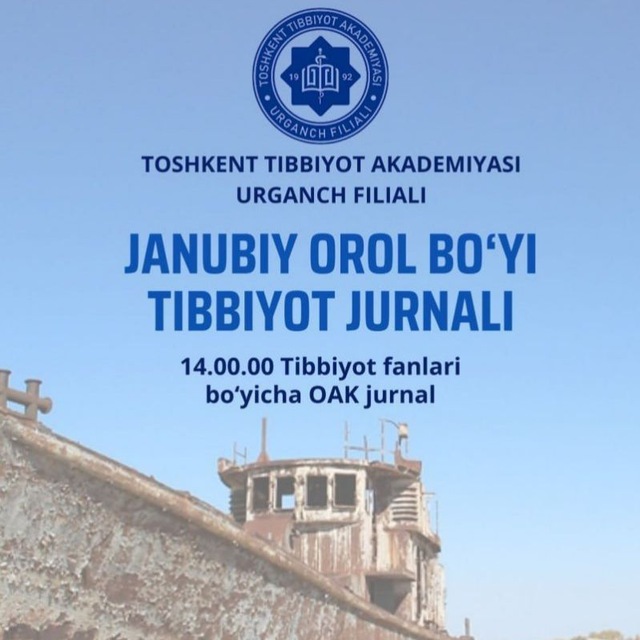РОЛЬ КЛЮЧЕВЫХ РОСТОВЫХ ФАКТОРОВ В НАРУШЕНИИ АНГИОГЕНЕЗА И РЕПАРАТИВНЫХ ПРОЦЕССОВ ПРИ СИНДРОМЕ ДИАБЕТИЧЕСКОЙ СТОПЫ
##semicolon##
ангиогенез,##common.commaListSeparator## гипоксия,##common.commaListSeparator## воспаление,##common.commaListSeparator## регенерация,##common.commaListSeparator## фиброз,##common.commaListSeparator## сосудистая дисфункция,##common.commaListSeparator## цитокины,##common.commaListSeparator## эндотелий.Abstrak
2-tip qandli diabet tomir va metabolik asoratlarning asosiy sabablaridan biri bo‘lib, angiogenez va to‘qimalarning tiklanish jarayonlari buzilishi bilan xarakterlanuvchi diabetik toʻpiq sindromi (DTS)ni o‘z ichiga oladi. Tadqiqotning maqsadi — sog‘lom shaxslar bilan solishtirganda, 2-tip qandli diabet (QD2) va DTS bilan og‘rigan bemorlarda VEGF-A, IGF-1 va TGF-β1 o‘sish omillari darajalaridagi o‘zgarishlarni aniqlash edi. Jami 84 nafar ishtirokchi tekshiruvdan o‘tkazildi va uch guruhga bo‘lindi: nazorat guruhi (n = 26), QD2 guruhi (n = 30) hamda QD2 + DTS guruhi (n = 28). O‘sish omillari kontsentratsiyasi sertifikatlangan to‘plamlar yordamida immunoferment tahlil (ELISA) usuli bilan aniqlangan. Natijalar QD2 bilan og‘rigan bemorlarda VEGF-A, IGF-1 va TGF-β1 darajalari nazorat guruhiga nisbatan ishonchli ravishda kamayganini ko‘rsatdi (p < 0,001). QD2 va DTS birgalikda kechgan hollarda bu ko‘rsatkichlarning pasayishi yanada yaqqol bo‘lib, normal qiymatlarga nisbatan 1,4–1,5 baravar past edi. Aniqlangan o‘zgarishlar angiogen faollikning susayishini, mikrotsirkulyatsiyaning buzilishini va to‘qimalarning regenerativ salohiyatining pasayishini aks ettiradi. Olingan ma’lumotlar tomir asoratlari xavfi yuqori bo‘lgan bemorlarda angiogen mediatorlar disbalansini erta aniqlash zarurligini tasdiqlaydi.
##submission.citations##
1. Abdalla M., Elhassan M., Osman S., et al. Serum leptin and adiponectin levels in patients with diabetic foot ulcers: correlation with insulin resistance and inflammation // Frontiers in Endocrinology. — 2023. — Vol. 14. — Article 1224031. DOI:10.3389/fendo.2023.1224031.
2. Border W. A., Noble N. A. Transforming growth factor beta in tissue fibrosis // New England Journal of Medicine. — 1994. — Vol. 331, No. 19. — P. 1286–1292. DOI:10.1056/NEJM199411103311907.
3. Chen L., Zhang Y., Li Y., et al. Adipokine imbalance and vascular complications in type 2 diabetes: focus on the role of inflammation // Metabolism: Clinical and Experimental. — 2024. — Vol. 155. — P. 155217. DOI:10.1016/j.metabol.2024.155217.
4. Gao F., Chen L., Li M., et al. Regulation of angiogenesis by VEGF-A signaling in diabetes and its complications // Journal of Molecular Endocrinology. — 2021. — Vol. 67, No. 2. — P. 79–94. DOI:10.1530/JME-21-0032.
5. Gubbi S., Quipildor G. F., Barzilai N., et al. Growth hormone and IGF-1 in aging and diabetes // Molecular and Cellular Endocrinology. — 2021. — Vol. 519. — P. 111–130. DOI:10.1016/j.mce.2020.111130.
6. International Diabetes Federation. IDF Diabetes Atlas. 11th ed. — Brussels: IDF, 2024. — 152 p. — ISBN 978-2-930229-91-8.
7. International Working Group on the Diabetic Foot (IWGDF). IWGDF Guidelines on the Prevention and Management of Diabetic Foot Disease. — 2023. — URL: https://iwgdfguidelines.org/guidelines (дата обращения: 24.10.2025).
8. Jiang Y., Wang C., Zhang J., et al. Mechanisms of TGF-β1 activation in chronic diabetic ulcers // Frontiers in Immunology. — 2021. — Vol. 12. — Article 654210. DOI:10.3389/fimmu.2021.654210.
9. Kiliç Ü., Öztürk M., Gülmez A., et al. Global prevalence of diabetic foot ulcers: a systematic review and meta-analysis // Diabetes Research and Clinical Practice. — 2025. — Vol. 213. — P. 111–119. DOI:10.1016/j.diabres.2025.111119.
10. Kim J., Park S., Kim J. H., et al. Reduced IGF-1 expression impairs keratinocyte migration and angiogenesis in diabetic wounds // Experimental Dermatology. — 2020. — Vol. 29, No. 11. — P. 1064–1072. DOI:10.1111/exd.14166.
11. Qin X., Wang Y., Zhang S., et al. Dysregulation of VEGF and TGF-β pathways in diabetic foot ulcers: a mechanistic link to impaired wound healing // Wound Repair and Regeneration. — 2025. — Vol. 33, No. 2. — P. 142–153. DOI:10.1111/wrr.13125.
12. Sidhu G. S., Yadav R., Nanda S., et al. Role of matrix metalloproteinases and cytokine profile in chronic diabetic wounds: correlation with angiogenic markers // International Journal of Molecular Sciences. — 2024. — Vol. 25, No. 4. — Article 2398. DOI:10.3390/ijms25042398.
13. Tian L., Hou X., Wang L., Zhang Y. Hypoxia-induced regulation of VEGF-A expression and its role in diabetic wound healing // Frontiers in Endocrinology. — 2022. — Vol. 13. — Article 927634. DOI:10.3389/fendo.2022.927634.
14. World Health Organization. Diabetes fact sheet. — Geneva: WHO, 2024. — URL: https://www.who.int/news-room/fact-sheets/detail/diabetes (дата обращения: 24.10.2025).
15. Wu C., Li J., Gao X., et al. Transforming growth factor beta signaling in wound healing and fibrosis in diabetes // Journal of Translational Medicine. — 2018. — Vol. 16, No. 1. — P. 1–12. DOI:10.1186/s12967-018-1583-0.
16. Wu Y., Sun Q., Chen G., et al. Circulating IGF-1 levels and metabolic outcomes in diabetes: a population-based study // Diabetes & Metabolism Journal. — 2021. — Vol. 45, No. 4. — P. 560–570. DOI:10.4093/dmj.2020.0158.
17. Xue M., Jackson C. J., Campbell D., et al. Dysregulation of TGF-β1 signaling in chronic wounds of diabetic patients: implications for antifibrotic therapy // Cells. — 2023. — Vol. 12, No. 2. — Article 270. DOI:10.3390/cells12020270.
18. Yuen K. C. J., Dunger D. B., Cutfield W. S. IGF-1 physiology and clinical implications in diabetes and wound healing // Diabetes Care. — 2022. — Vol. 45, No. 7. — P. 1598–1609. DOI:10.2337/dci21-0043.
19. Zhang X., Zhang G., Zhang H., et al. Impaired HIF-1α and VEGF expression in diabetic wound healing: role of hyperglycemia and oxidative stress // International Journal of Molecular Medicine. — 2019. — Vol. 44, No. 2. — P. 423–433. DOI:10.3892/ijmm.2019.4217.
20. Zhou B., Afshin A., Bixby H., et al. Global trends in diabetes prevalence, diagnosis, and control from 1990 to 2022: a pooled analysis of 680 population-based studies with 27 million participants // The Lancet. — 2024. — Vol. 403, No. 10414. — P. 1123–1139. DOI:10.1016/S0140-6736(24)00123-5.




